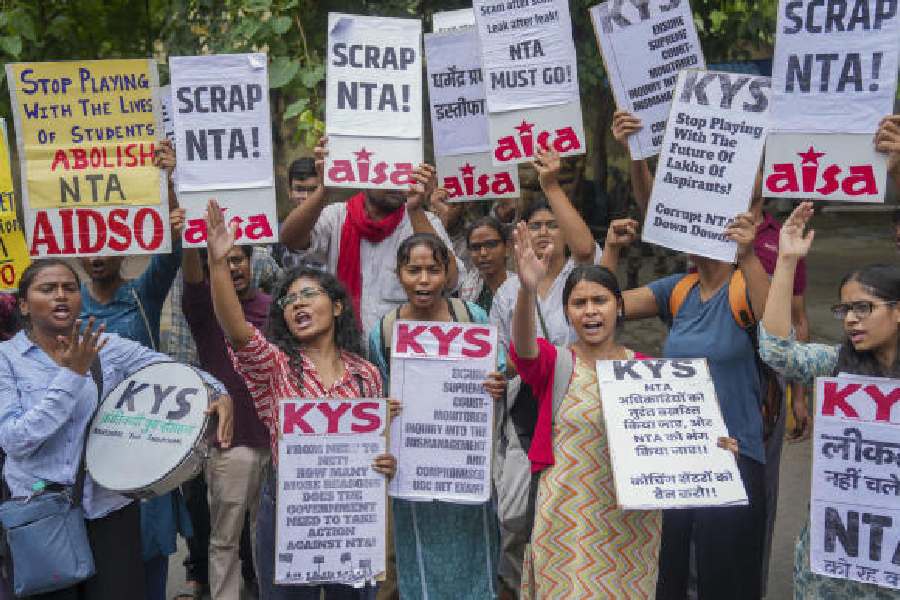Director Saptaswa Basu’s film Network follows Abhijit Ganguly, a reputed film director, who has lost his fame and glory after a series of flops. After getting diagnosed with a terminal disease, he decides to make a last film but fate does not favour him and his concept gets stolen by a few people close to him. “He goes into the shadows and creates a wicked reality TV show in order to trap the fraudsters in each episode and punish them. It’s a suspense thriller against the backdrop of the media industry,” says Saptaswa about his debut film, which released in 2019. Now, Network is streaming on Amazon Prime Video. The Telegraph chat with Saptaswa.
How’s the feedback once the film started streaming on Amazon Prime Video?
The response has been positive and it’s quite a nostalgic feeling as the first film is always very special. Since people have seen a few other works of mine now, they have compared it to the other works and few have said that the first one (Network) has its own place in terms of uniqueness and narrative. In a retrospective lens, I have discussed with the viewers about certain pointers that I could have handled better but it’s a learning curve and I am accepting the positive response that’s coming along from this viewership.
Did you come across certain observations from the audience that surprised you?
The audience have decoded the film from their own perspective. Many praised the theme of voyeurism, of looking into the private moment of others and compared it to our modern lifestyle of turning every moment into Reels or encroaching in others’ space. The subtle messages of nihilism are well understood by the viewers.
In streaming they are able to pause, rewind and re-view certain scenes and find imagery or metaphorical connections that can get missed in the one-time watch. So yes, I am quite happy and surprised with these observations and comments.
Was Network meant for the web?
Network was always meant to be my first feature film. I designed it and framed it for a theatrical release only. When I was making it there were not that many OTT platforms in Bengali and when I finally completed it, I found that the streaming service is slowly taking dominance. Still we were fixed at our target as publishing a film in theatrical print is very special and considered to be a milestone for any film-maker. It has a storyline of a TV show which traps its participants in different episodes and therefore the second half of the film has a episodic narrative as well, but the 150 minutes length of the content was divided into the five act structure for a film narrative exclusively.
What kind of challenges did you face when you had to release Network in the theatres?
Bringing a film in theatres is always a challenge. We are facing new challenges even now. There was a myriad of challenges back then for me. Getting good showtimes and adequate halls are important. When I released Network, at that time Kabir Singh was running and Spiderman got released as well, we were really cornered but still managed to get a number of good shows.
It takes a bit of time for an indie film to pick up the buzz in the market which it did in the following weeks. I still sometimes visit the audience reviews and public reactions available in different YouTube links to cherish those memories.
Every day I used to wake up and scroll through the ticketing portals to find out the booking percentage in each halls and whether we have secured shows in the following week. It was quite a time of excitement, anxiety and happiness.
Would you have done certain things differently?
When I look back to any film of mine, I think of 100 things that I could have done differently. There is no right or wrong in the aesthetic space of art and there is no end to perfection as well. For Network, I will stand by the making and the independent approach that I executed over two years in completing it, therefore I like the way that it is, a bit flawed. Of course, if I could change one thing, I would have reduced the duration by 15 minutes with a better planning as that would have made it more compact and would have attracted better showtimes in theatres.
How do you look back on the film now?
I have the printed posters of the film in my apartment and it’s a constant reminder of my roots from where I started the big screen journey. It has paved the path of my consecutive works and now I stand at the brink of release of my fourth film Doctor Bakshi. Therefore I will always keep it aside as something monumental for me, which me and my family and a core group of friends toiled to create without having any good financial support or any extra aid at all. Each stage of post, CG work, 5.1 mix, colour process in Baselight, everything was new to me and I absorbed everything to learn more and more.
What is the USP of Network?
The USP of Network definitely lies in its concept and the conflict portrayed between the lead characters. A thriller set in the backdrop of a reality TV show is fresh content in our regional cinema and it attracted a good amount of audience. We get to see two senior and strong performers pitted against each other while the younger cast went through a series of edge-of-the-seat moments. The USP lies in the treatment itself and therefore it has worked well on the streaming platform also.
Tell us about some of the memorable moments while you were making the film?
The first time when both Saswatada and Sabyasachida gave a shot together was really memorable. I grew up watching their work on TV and film. It felt like I knew them for so long, yet not, and was mesmerised by the surreal feeling of the moment. My mother used to visit the set some times and bring home-cooked meals for some of the cast and crew members and they always used to love having that. Sabyasachida discussed different lenses with me as he is a pro in photography and camerawork and Saswatada kept the mood of the set lively and fun.
We shot in and outside of Indira cinema. It was the first time when I shot on the roads with a celebrated artiste and there was a good crowd. Handling the crowd and coordinating with the crew on a walkie talkie felt very memorable. We took police permission and cordoned off a small section of a bylane for some time so as to create the scene where Abhijit Ganguly (Saswata) is walking alone on the street and entering a single-screen theatre to relive his memories. That sequence itself is a distinctive point in the film.
Creating the TV show set in Purple Movie Town was both challenging and educative. Shooting in a real local train in Sodepur station was a bit scary as I was concerned about the safety of the camera and the artiste as there was unnatural commotion. In the sequence where a character gets hanged inside a theatre, I applied the usage of wireframes for the first time and it looked risky, yet spectacular. The variation of scenes present in Network, ranging from drama to suspense to a hard hitting climax with fire blast in glass box, are definitive and extraordinary moments which I will carry for the lifetime.
Do you feel Network would have fared differently at the box office if you had released it now?
It’s a very unpredictable scene at the box office. For example, no one could anticipate such a humongous box-office collection of the film Kantara this year. When Network released, we had to do a limited release due to restriction of funds. If I released it now, probably I would have got a greater promotional support and twice the number of theatres but then it wouldn’t have been my first film and some other work would have been my debut. So that’s an alternate reality altogether and probably it would have attracted a far better boxoffice figures now, but I am content with its ongoing run on OTT and it provides an easy way for thousands of viewers around the globe to play my work with a single click.










